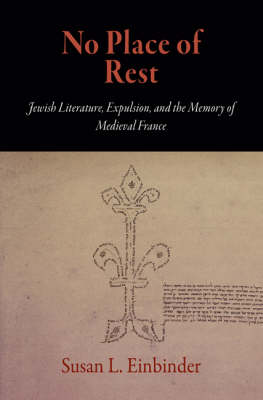The Middle Ages
2 total works
When King Philip VI expelled the Jews in 1306, some 100,000 men, women, and children were driven from royal France into the neighboring lands of Spain, Provence, Italy, and North Africa. The great expulsion of 1306 was arguably one of the most traumatic moments of medieval Jewish history and would prove to be the harbinger of a series of recalls and expulsions, local and general, culminating in King Charles VI's expulsion decree of 1394.
Despite the upheavals of the fourteenth century, the literary productivity of Jews was astonishing. Yet there are few direct references to the catastrophic events of 1306, even in Jewish liturgical and historiographic texts, where one would expect to find them. In No Place of Rest, Susan Einbinder coaxes out the literary traces of this traumatic expulsion. Why did the memory of this proud and vibrant Jewish community fade from historical memory? Where do its remnants reside among later communities and readers? From the lyrics of the supposed "Jewish troubadour" Isaac HaGorni to medical texts and astronomical charts, Einbinder studies a range of writings she reveals to be commemorative. Her careful readings uncover the ways in which medieval Jews asserted their identity in exile and, perhaps more important, helped to preserve or efface their history.
The Black Death of 1348-50 devastated Europe. With mortality estimates ranging from thirty to sixty percent of the population, it was arguably the most significant event of the fourteenth century. Nonetheless, its force varied across the continent, and so did the ways people responded to it. Surprisingly, there is little Jewish writing extant that directly addresses the impact of the plague, or even of the violence that sometimes accompanied it. This absence is particularly notable for Provence and the Iberian Peninsula, despite rich sources on Jewish life throughout the century.
In After the Black Death, Susan L. Einbinder uncovers Jewish responses to plague and violence in fourteenth-century Iberia and Provence. Einbinder's original research reveals a wide, heterogeneous series of Jewish literary responses to the plague, including Sephardic liturgical poetry; a medical tractate written by the Jewish physician Abraham Caslari; epitaphs inscribed on the tombstones of twenty-eight Jewish plague victims once buried in Toledo; and a heretofore unstudied liturgical lament written by Moses Nathan, a survivor of an anti-Jewish massacre that occurred in Tàrrega, Catalonia, in 1348.
Through elegant translations and masterful readings, After the Black Death exposes the great diversity in Jewish experiences of the plague, shaped as they were by convention, geography, epidemiology, and politics. Most critically, Einbinder traces the continuity of faith, language, and meaning through the years of the plague and its aftermath. Both before and after the Black Death, Jewish texts that deal with tragedy privilege the communal over the personal and affirm resilience over victimhood. Combined with archival and archaeological testimony, these texts ask us to think deeply about the men and women, sometimes perpetrators as well as victims, who confronted the Black Death. As devastating as the Black Death was, it did not shatter the modes of expression and explanation of those who survived it—a discovery that challenges the applicability of modern trauma theory to the medieval context.

